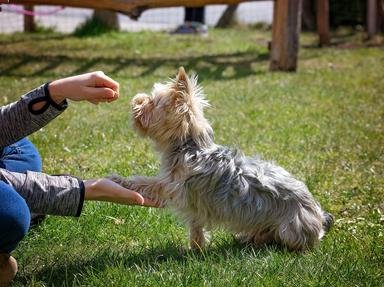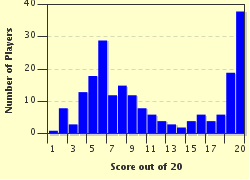Quiz Answer Key and Fun Facts
1. This quiz is about the sport based on the tradition of sending small dogs into an animal's burrow to kill it and/or root it out. Of course, today's trials are to test the dogs instincts, and no animals are killed in the process. The sport has been called by a number of things. Which one is not a name for this?
2. As with most trials based on instinct, earthdog trials are limited to certain breeds (or certain mixed breeds, with some organizations). A general rule is all small terriers are permitted to participate. (See next rule for further clarification.) Which non-terrier breed is also allowed to play?
3. In addition to the small terriers in the Terrier Group, two toy terrier breeds (from the Toy Group) are permitted to participate in AKC trials. What is that breed?
4. "Den liner" is a common term used by earthdog aficionados. Yes, it's the thing that the dogs run through, but what is an earthdog tunnel, anyway? What is a den liner?
5. So just what is it at the end of the tunnel that gets the dogs so eager to race down a dark tunnel? (Or, in the case of one puppy I know, bark in great trepidation at the scary dark tunnel with very interesting smells coming out of it.)
6. IQ is the first test that many beginning earthdogs pass. It stand for "Introduction to ..."
7. At AKC earthdog tunnels, judges can lightly scent the area around the tunnel. What do they use to create this scent?
8. In IQ, what can the handler do to encourage his dog to pass?
9. In IQ, what can the judge do to encourage the dog to pass?
10. Once a dog gets to the end of a tunnel, he's required to "work the quarry."
This is intended to imitate a working dog who gets to the end of a real tunnel. He may find an animal that he can dispatch himself. Or he may need to dig to get to it. Or he may need to bark so his owner knew where to dig to dig up this varmint.
The rats are in a cage, which is then protected by wooden bars, so they're completely safe.
At American Working Terrier Association Trials, all of the below methods are acceptable methods of "working the quarry." However, one of these is not acceptable by AKC standards. Which one would cause a dog to fail at an AKC trial if he only did this?
11. Can you enter Junior Earthdog (JE) without having passed IQ?
12. IQ tunnels are approximately 10 feet long with one turn. The next level, Junior Earthdog, has tunnels that are approximately 30 feet long with three 90 degree turns.
In Introduction to Quarry, dogs are required to get to the end of the tunnel and start working the quarry within two minutes.
In order to pass Junior Earthodg how long should it take the dog to get from the start (where his owner releases him) to the quarry, and how long should it take him from the time he gets to the end of the tunnel to start working the quarry?
Remember that Introduction to Quarry is an introductory level. Junior Earthdog is where the real work begins. Just because it takes two minutes for a 10-foot tunnel does not mean it should take six minutes for a 30-foot tunnel.
13. In Junior Earthdog, if, after the dog enters the tunnel, he exits and re-enters the tunnel, can he still pass?
14. Senior Earthdog introduces several new challenges to the dogs. Which of these are NOT part of the new challenges of Senior Earthdog?
15. Dogs that have been trained to work quarry often find it really difficult to voluntarily leave the den at their owner's call. What does the judge do to help the dogs be more inclined to return to their handler?
16. When the judge signals the handler to recall his dog, he may give one command. He may call the dog or he can use what tool to get it out?
17. Finally, the dog is at Master Earthdog. In a real working situation, a dog would often be working with other dogs. In Master Earthdog, two dogs work together.
In lure coursing (a sport for sighthounds), dogs are run with their own breed. You will only see dogs of different breeds running together in the end, when they compete for Best in Field. If there is only one dog of a breed present, he will run alone.
In earthdog, can a dog be braced with a dog of any breed?
18. In master earthdog, the judge, two handlers and two dogs start at a point 100-300 yards distant from the earthdog tunnel. They stroll along towards the tunnel. The dogs are expected to be "working" looking for the tunnel. They may not interfere with their bracemate. The handlers are free to call or instruct their own dogs. A short empty den is placed along the way. The dogs must check out this den and confirm that it's empty.
They continue walking along until they come upon the real den. Once one dog finds the tunnel, the second dog should also demonstrate interest in it. (At this point, the den entrance is sealed.)
What happens next?
19. Master Earthdog introduces a new aspect to simulate a real working situation. What is that?
20. Finally, a new sport has recently emerged based on earthdog but for larger dogs. It's been in planning and development for several years, but it was just provisionally recognized by AWTA. It is designed to imitate a working dog that is required to go into a tunnel and drag a large animal out of its den.
This sports involves a straight tunnel that is larger than in earthdog (about 11 inches). The dog runs in, grabs a badger skin that has been weighed down to make it heavier and drags it out.
What is this sport called?
Source: Author
remobec
This quiz was reviewed by FunTrivia editor
crisw before going online.
Any errors found in FunTrivia content are routinely corrected through our feedback system.

